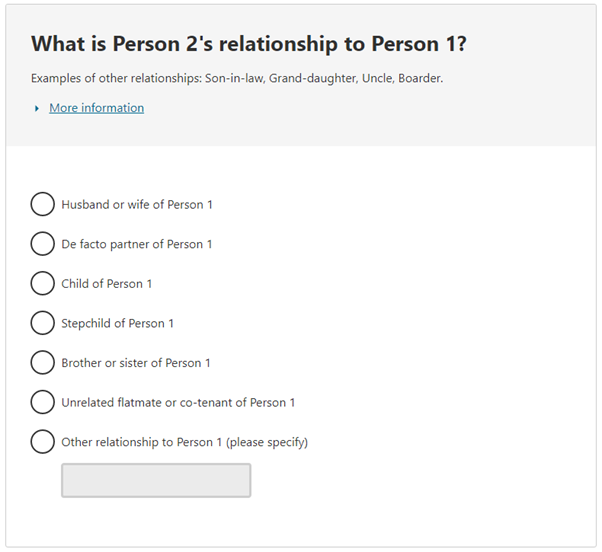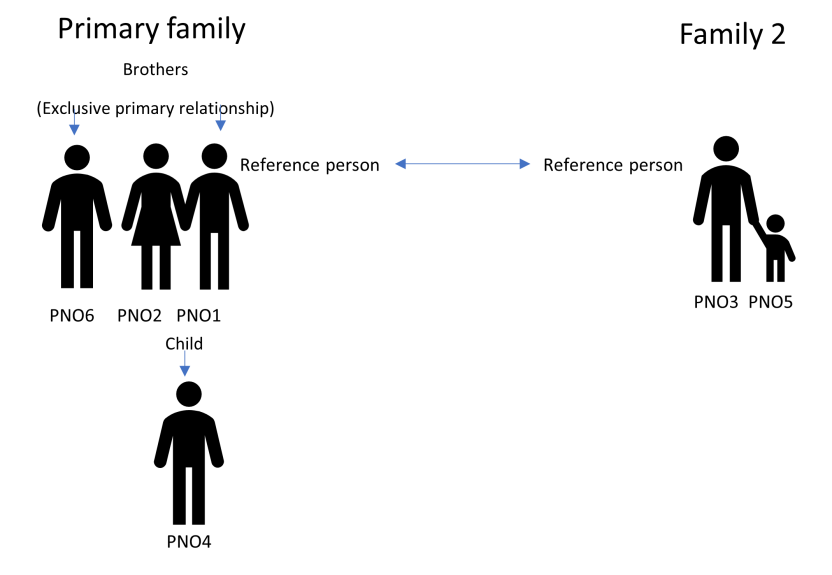Understanding Family composition and Grandparent families
Exploring the purpose, concepts and limitations of family data
Why is family data important?
The Census provides an opportunity to show how families are structured nationwide. Census family data provides valuable insight into the people of Australia which can be used by decision makers to inform policies and initiatives in many areas, such as the aged care, education and housing sectors.
A wide variety of living arrangements exist in Australia, so family structures can be complex, dynamic and difficult to capture. For example, grandparent and grandchild families are not able to be reflected in standard family Census variables.
While family data is sought after, there are limitations with how this information is gathered in the Census and this needs to be considered when interpreting the data.
What is a statistical family?
In the Census, a family is:
- two or more people who usually live in a household
- at least one of these people was home on Census Night
- one person is at least 15 years of age
- they must be related (including de facto, step, fostered and adopted relatives).
Two family members form a family nucleus which will consist of either:
- a couple (married or de facto)
- a lone parent and a child
- or other pairs (e.g. grandparent and grandchild, siblings).
Other related family members living in the same household are attached to the family nucleus.
Who is not included in a statistical family?
People who are living in a household together but are not related, or are related but do not usually live in the household (and therefore considered visitors on Census Night), are not connected to a family nucleus. For example:
- visitors, either locally or from overseas
- friends or unrelated flatmates
- boarders or lodgers.
What is a non-family household?
While all families belong to a household, not all households have families.
People living in the same household who are not related likely belong to a non-family household. These include:
- lone person households
- group households (e.g. unrelated housemates living together)
- visitor only households (people who are not usual residents e.g. holiday home)
- non-classifiable households (where there’s not enough relationship information or the only residents are under 15 years of age).
Multiple family households
A multiple family household refers to a household that can form more than one family nucleus. For example, each couple could form their own family.
A maximum of three family nuclei can be captured in one household.
All related persons in a household must be attached to a nucleus.
Image

Description
Information about spouses, parents and children who are temporarily absent on Census Night is also used to establish the family relationship.
See Persons temporarily absent for more information about how PTAs are captured in Census data.
Families on the Census form
Family and household relationship information is primarily taken from the Census form question, “What is the person’s relationship to Person1/Person2?”
Image

Description
Data from other questions may be needed when coding families and relationships to help explain or further define relationships. This is often taken from age, sex and marital status data.
For example, if a person aged 10 years was present in the house and had not provided their relationship to Person 1, they would likely be coded as the child of Person 1, if Person 1 has indicated they have children.
The table below indicates what relationships are attached to families in Census data.
| Relationship to Person 1 | Can be attached to a family |
|---|---|
| Parent | Yes |
| Spouse/partner | Yes |
| Child (including step/foster/adopted) | Yes |
| Uncle/aunt | Yes |
| Niece/nephew | Yes |
| Grandparent | Yes |
| Cousin | Yes |
| In-laws | Yes |
| Other related individual (e.g. great uncle/step cousin) | Yes |
| Godparent/godchild | No (unless they are related, e.g. aunt/nephew) |
| Friends | No |
| Nanny/carer | No (unless they are related, e.g. niece) |
| Visitor/overseas visitor | No (even if they are related) |
How is a family nucleus formed?
A family nucleus is the centre of a statistical family, formed by two related people. To determine the nucleus, we need to know who is in the household and how they relate to each other.
First, we look at the person numbers (PNO) and identify if anyone is related to Person 1 (PNO1) on the Census form. Then we look at how they are related.
For example:
- PNO1: PNO1
- PNO2: Spouse of PNO1
- PNO3: Child of PNO1 and PNO2
- PNO4: Child of PNO1 and PNO2
Image

Description
In this example, we can identify the family has a couple nucleus. We can now attach other family members (PNO3 and PNO4) to this nucleus.
Family nucleus order priority
When determining nuclei, we look for a couple nucleus first. A couple nucleus is formed when two people (both aged 15 years or over) are in a registered marriage or a de facto relationship and usually live in the same dwelling.
If we can’t identify a couple, we look for a lone parent and child nucleus. This type of nucleus is formed between a parent and a child living in the same household when neither live in a couple relationship in that household. There may be multiple children in the household who would then be attached to this nucleus.
If we can’t identify a couple or lone parent and child nucleus, but there are related persons in the household, we look for other pairs to form a nucleus. This type of nucleus is formed between two related people (at least one person aged 15 years or over) that usually live in the household, but who don’t belong to a couple or parent-child relationship (e.g. grandparent and grandchild or siblings).
Once the nucleus type has been determined, we can then identify the reference person and attach other related family members.
What is a reference person?
The reference person forms the basis of a statistical family. The reference person must be:
- at least 15 years of age
- a usual resident of the household
- home on Census Night.
The captured reference person is usually PNO1 on the Census form. However, sometimes we need to change the reference person to preserve the data quality of the relationship or family.
Persons temporarily absent (PTAs) cannot be the reference person. See Persons temporarily absent for more information about how PTAs are captured in Census data.
In a household with a couple or other pair nucleus, the reference person is usually the person in the nucleus who has the lowest PNO on the Census form. In a lone parent and child nucleus, the reference person is always the parent.
Example: An unattached sibling fills out the Census form when their sibling is in a couple in the house.
- PNO1: Captured reference person
- PNO2: Brother
- PNO3: Sister-in-law
- PNO4: Niece
- PNO5: Nephew
Because we can determine a couple nucleus, the reference person must be changed to PNO2, and the children and brother attached to the couple nucleus. The above example would now become:
- PNO1: Brother
- PNO2: Reference person
- PNO3: Spouse
- PNO4: Child of reference person and spouse
- PNO5: Child of reference person and spouse
Multiple reference persons
Each family nucleus can only have one reference person. In large households, it may be necessary to form multiple nuclei. Due to system limitations, only three nuclei can be coded in one household which means there can be a maximum of three reference people.
When we create a new family in a household, we need to number them family 1 (primary family), family 2 and family 3 (if applicable).
Example of multiple family household: A couple with their children and grandchild.
- PNO1: Reference person
- PNO2: Spouse of PNO1
- PNO3: Child of PNO1 and PNO2
- PNO4: Child of PNO1 and PNO2
- PNO5: Grandchild of PNO1 (Child of PNO3)
Because PNO3 and PNO5 can form a lone parent and child nucleus, we can also make PNO3 a reference person. We can relate the reference person of family 2 to the reference person of the primary family.
- PNO1: Reference person (family 2)
- PNO2: Spouse of PNO1 (family 2)
- PNO3: Reference person (primary family)
- PNO4: Child of PNO1 and PNO2 (family 2)
- PNO5: Child of PNO3 (primary family)
Determining the primary family
The primary family is determined in order of priority:
- exclusive primary relationship
- highest number of dependents (if same number in each family, use family with youngest dependent)
- lowest PNO.
Exclusive primary relationships are any related person, who is not a spouse or child. They are usually attached to the nucleus of the person they are most closely related to. See the 'Who is related?' table.
In the example above, the lone family and child nucleus is the primary family because they have a dependent child (less than 15 years of age). However, if PNO1 had their brother living in the house this would alter who is the primary family.
The example would become:
- PNO1: Reference person (Primary family)
- PNO2: Spouse of PNO1 (Primary family)
- PNO3: Reference person (family 2)
- PNO4: Child (adult) of PNO1 and PNO2 (Primary family)
- PNO5: Child (6 years) of reference person (family 2)
- PNO6: Brother of PNO1 (Primary family)
PNO6 would be attached to the couple nucleus because brother is a closer relationship than uncle. The couple nucleus would form the primary family because it contains an exclusive primary relationship.
Image

Description
Coding limitations
Capturing accurate family data is complicated and can be limited by the way respondents answers the questions, and the design of the Census form.
Person number order
Relationships between people in the household may be misinterpreted or not accurately captured depending on the order in which respondents in the household number themselves on the form.
Example 1: An adult child fills out the form for their family on Census Night:
- PNO1: Captured reference person
- PNO2: Other relationship to person 1 (Mother)
- PNO3: Other relationship to person 1 (Father)
- PNO4: Brother or sister of person 1
This family would be manually coded to capture accurate family data. The reference person will be changed to be either the mother or father as members of the family nucleus.
Example 2: Three friends live in a household. Two of them are brothers, but the unrelated friend fills out the Census form:
- PNO1: Captured reference person
- PNO2: Unrelated flatmate
- PNO3: Unrelated flatmate
The family structure in this household is not captured. There is no opportunity to reflect that PNO2 and PNO3 are brothers on the form.
Relationship to Person 1
Respondents may misinterpret their relationship to Person 1. For example, Person 2 may indicate they are unrelated to Person 1, when they are in fact in-laws.
Coder’s interpretation
During the coding process, coders often have to interpret relationships within a household based on the information available. Depending on how the respondent answered the question, families may not be captured.
Example: Four people share a house. Two of them are married, but an unrelated flatmate fills out the Census form:
- PNO1: Captured reference person
- PNO2: Unrelated flatmate
- PNO3: Unrelated flatmate
- PNO4: Unrelated flatmate
The couple family is not reflected here. However, if the coder sees that two people in the house are married and share the same last name, they can manually code the family.
Variables
Family composition (FMCF) is the main family variable that classifies families into different family types (except grandparent families).
When classifying a household, Household composition (HHCD) is used.
For more information on family variables see the 2021 Census dictionary: Household and families.
Grandparent families
Grandparent families are recognised where there is a grandparent-grandchild relationship in a family and no parent-child relationship.
Information that can be provided on grandparent families from the Census has limitations, in that grandparent families variables cannot be used with standard family and relationship variables. The definitions are different and so when grandparent families variables are used in combination with others, the resulting data may be incorrect.
Grandparent families data is available in three variables:
- Grandparent families (FMGF)
- Child type (including grandchildren) (CTGP)
- Relationship in household (including grandchildren) (RLGP)
These variables are variants of the standard family and relationship variables.
| Standard variables | Grandparent variables |
|---|---|
| RLHP (Relationship in household) | RLGP (Relationship in household, including grandchildren) |
| FMCF (Family composition) | FMGF (Grandparent families) |
| CTPP (Child type) | CTGP (Child type, including grandchildren) |
Note: Grandparent family variables cannot be used in conjunction with standard variables.
Relationship in household (RLHP) and Relationship in household, including grandchildren (RLGP)
Both variables describe the relationship of each person in a family to the family reference person, or where a person is not part of a family, that person's relationship to the household reference person.
RLGP classifies grandchildren, including those aged 15 years and over, as a 'child' whereas RLHP classifies persons aged 15 years and over as 'other relative'. A grandchild type would have a relationship of 'dependent student' or 'non-dependent child' in RLGP, whereas in RLHP it would be ‘other relative’ .
RLHP is used in standard family composition coding and to be categorised as a grandchild, the child must be aged less than 15 years. They are then designated a 'parent-child' type relationship with the grandparent. To be categorised as a non-dependent grandchild, the grandchild must be aged 15 years or more. A parent-child relationship can only be established where there is a grandchild under 15 years. Hence in the absence of a grandchild under 15 years, grandparent families may be classified as 'other family'.
Family composition (FMCF) and Grandparent families (FMGF)
The FMCF and FMGF variables both classify families into different family types, depending on the composition of the family. When classifying families into different types, information about temporarily absent family members is used. See Persons temporarily absent for more information.
The focus of the FMGF classification is on grandparent families only.
For example, if using FMCF, a sole grandparent with at least one grandchild would be coded as an other pairs family. The same family would be classified as a lone parent and child family using FMGF. A grandparent couple with a least one grandchild would be coded as a couple family with the grandchild attached as an exclusive family relationship in FMCF. In FMGF, this family is classified as a couple family with children.
When using grandparent variables, the grandchild is treated as a type of child.
Child type (CTPP) and Child type including grandchildren (CTGP)
The CTPP and CTGP variables both identify parent-child relationships within families. CTGP recognises grandparent-grandchild relationships as parent-child relationships, regardless of the age of the grandchild.
In CTPP, a person aged 15 years or more and has the relationship of grandchild is treated as an ‘other relative’. That is, if there is a sole grandparent in the family, the family is coded as an ‘other family’.
In CTGP, a sole grandparent is classified as a ‘lone parent’ and a family with a grandparent couple is classified as a ‘couple family with children’. The grandchild would have a relationship of 'dependent student' or 'non-dependent child', rather than ‘other relative’.
Nature of family relationships
It is important that we do not make assumptions about the nature of relationships in families, especially in relation to care. The standard family variables and the variation grandparent family variables indicate the family structure only.
For example, a 20-year-old grandchild who lives with their grandmother may be a full-time student who is dependent on their grandmother for care. Alternatively, the 20-year-old might live with their grandmother to provide care.